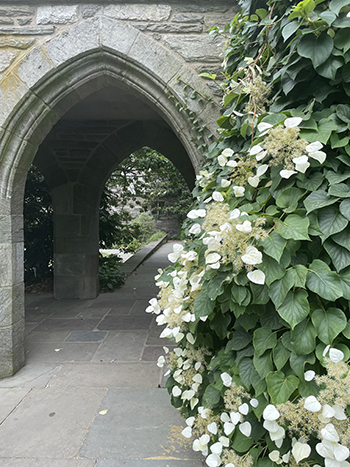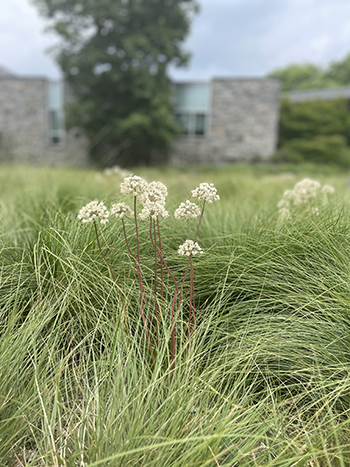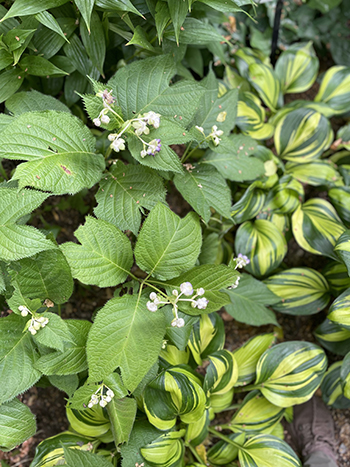
Plants of the Week: June 19
Guest Author: Fabienne Adler, 2023 Summer Intern
Spring is coming to a close, and with it ends the fireworks of peonies and roses. New beauties follow, some of them profuse and showy, others delicate and understated.

This week, a wonderfully reliable woody vine, Hydrangea hydrangeoides ‘Moonlight,’ is putting on a display at several locations on campus, including the entrance to the Theresa Lang Garden of Fragrance next to Clothier Hall. This woody-stemmed climbing vine hails from Japan, hence its common name: Japanese hydrangea-vine. Its attractive, deep green, heart-shaped leaves will drape over a low wall or climb up an arch stylishly and effortlessly but the star of the show is its bloom, which combines flat, lacy clusters of tiny white flowers and a profusion of splendid white bracts. This hydrangea ushers in the new season with generosity and pizzazz, and for me the ’Moonlight’ cultivar, with its moon-kissed foliage, is love at first sight.
Plant it in rich, sufficiently moist, well-drained soil, where it will enjoy part to full shade. It is deciduous, its foliage initially turning yellow in the fall, followed by reddish stems that provide some winter interest. It can be pruned in late winter or early spring, and, though fairly slow to establish, once in place it is generally problem free. Photo Credit: F. Adler.

Who knew that a flat, sunny, triangular strip designed to absorb water runoffs between the Science Center and the Cornell Science Library could be just the place for abstract poetry? Yet it’s just what I found, in the shape of a large swath of prairie dropseed (Sporobolus heterolepis) punctuated with Allium amplectens ‘GracefulBeauty’ (the West-coast native narrowleaf onion). When slender burgundy stems topped with perfect little white onion heads sway in the breeze, the contrast between the softly arching foliage of the grass and the allium’s delicate umbels works its magic. Simple, soothing, and effective.
This Allium blooms right as others bow off the stage, without fanfare but looking oh so dainty. Plant this lovely little bulb in groups in the fall. It will bloom in late spring, persist into the summer, and come back year after year. As with other Allium, the foliage is unremarkable and tends to wither just as the flower blooms, but the stem, which reaches 10 to 15 inches above the ground, has a striking color. This Allium enjoys well-drained, dry to moist soils and full sun. Photo Credit: F. Adler.

The Harry Wood Courtyard Garden brings woodland wonders right to the doors of the Science Center. There’s always something delightful going on there, and right now, our gardeners are feeling especially enthusiastic about Deinanthe caerulea (false hydrangea) which is putting out its first bloom. This relative of the hydrangea is not a woody plant but a herbaceous perennial native to the cool, moist, shady woodlands of Central China. Its deeply lobed, dark green leaves surprise with their tulip-like silhouette, while its delicate flowers hang upside down like small blue cups packed with frilly stamens. Some plants are loud and bold but this one, like many other woodland gems, whispers: it invites you to crawl on your knees and lift up a bloom with a delicate finger.
Deinanthe requires rich, moist soil and part to full shade. It will not thrive in full sun or a dry spot (drying winds are a no-no). It is perfect for a woodland garden. Here at the Harry Wood Garden it thrives amongst Helleborus, Hosta, and Enkianthus. Once established, its care is straightforward. Photo Credit: F. Adler.





Robert Roggeveen
Posted at 08:45h, 13 JulyA very welcome arrival in my email box – I had planted a Hydrangea hydrangeiodes ‘Moonlight’ bought just the day before. I will have to look into Deinanthe. Intriguing. Your posts are always a joy to read. Thank you!
Becky Robert
Posted at 08:58h, 13 JulyDear Robert,
Thank you for following our blog. We love H. ‘Moonlight’. It is such a work horse of beauty in the garden. I hope it adds delight to your garden too.
Sincerely,
Becky Robert
Scott Arboretum